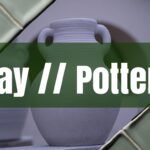Embarking on the journey of pottery at home is an adventure filled with creativity, tactile exploration, and the satisfaction of crafting functional and beautiful objects with your own hands. It might seem daunting at first, but with the right guidance and a bit of patience, you can transform your living space into a personal pottery studio. Let’s explore the essential steps and considerations to confidently begin your home pottery practice. For those considering teaching, there are some great resources available on how to teach pottery.
Essential Tools for Your Home Pottery Studio
First things first, let’s talk about the tools you’ll need to get started. You’ll need clay, of course! We’ll delve into different types later. Then, consider how you want to shape your clay. A pottery wheel is fantastic for creating symmetrical pieces, but hand-building is equally rewarding and requires no specialized equipment. You can find beginner-friendly pottery wheels online, some even designed for kids, featuring adjustable speeds and tools. Alternatively, for hand-building, your hands are your primary tools, supplemented by a few simple implements.
Now, for the specific tools themselves:
- A rib is essential for shaping and smoothing clay, especially on the wheel. They come in wood, rubber, or metal, each serving a different purpose. Wooden ribs are great for initial shaping, while rubber and metal ribs excel at smoothing.
Wooden ribs are great for initial shaping, while rubber and metal ribs excel at smoothing. Susan Ohanlon Pottery highly recommends ribs designed by potters for potters, and a good metal rib should have some flexibility to remove excess slip. Rubber ribs, like the kidney-shaped ones from MUD Tools, are indispensable, especially the red (most flexible) and yellow (slightly stiffer) versions.
- You will also want a trimming tool. Trimming tools help scrape away excess clay to refine your piece’s shape. These usually have a wooden handle with a ribbon-like metal attachment.
You will also want a trimming tool. Trimming tools help scrape away excess clay to refine your piece’s shape. These usually have a wooden handle with a ribbon-like metal attachment.
- Sponges are incredibly versatile. They can smooth out finger lines, clean workspaces, and remove dust. Special sponges, like sponge-on-a-stick, can even soak up water from tall pieces
Sponges are incredibly versatile. They can smooth out finger lines, clean workspaces, and remove dust. Special sponges, like sponge-on-a-stick, can even soak up water from tall pieces.
- Brushes are used for applying slip (a wet clay mixture) when joining clay pieces and for applying glazes.
Brushes are used for applying slip (a wet clay mixture) when joining clay pieces and for applying glazes.
- A needle tool is useful for trimming, etching, and piercing clay. Susan Ohanlon Pottery recommends the Mud Shark Needle Tool for its safety and versatility.
A needle tool is useful for trimming, etching, and piercing clay. Susan Ohanlon Pottery recommends the Mud Shark Needle Tool for its safety and versatility.
- You’ll need a wire cutter to divide clay blocks, remove pieces from the wheel, and level rims.
You’ll need a wire cutter to divide clay blocks, remove pieces from the wheel, and level rims.
- Calipers are essential for measuring inner and outer dimensions, ensuring pieces fit together perfectly, like lids for jars or cups and saucers.
Calipers are essential for measuring inner and outer dimensions, ensuring pieces fit together perfectly, like lids for jars or cups and saucers.
- Finally, you’ll require an apron and towels for easy clean-up.
Finally, you’ll require an apron and towels for easy clean-up. Also, remember that a kiln is necessary for firing pottery. For those looking to expand their skills, consider mastering the art of pulled pottery handles.
Choosing the Right Clay
Choosing the right clay is crucial for a successful start. Earthenware clay is a great option for beginners because it’s easy to work with and fires at a relatively low temperature, typically between 1,800 and 2,200 degrees Fahrenheit. Terracotta is a popular type of earthenware. However, it’s not as strong as other clays.
Earthenware clay is a great option for beginners because it’s easy to work with and fires at a relatively low temperature, typically between 1,800 and 2,200 degrees Fahrenheit. Terracotta is a popular type of earthenware. However, it’s not as strong as other clays.
Stoneware clay is another excellent choice, stronger and more durable than earthenware, firing between 2,300 and 2,400 degrees Fahrenheit. For basic handbuilt pottery and wheel throwing, mid-range stoneware is very forgiving.
Stoneware clay is another excellent choice, stronger and more durable than earthenware, firing between 2,300 and 2,400 degrees Fahrenheit. For basic handbuilt pottery and wheel throwing, mid-range stoneware is very forgiving.
Porcelain clay, known for its white color and translucency, is the strongest but also the most challenging to work with, requiring firing temperatures between 2,400 and 2,600 degrees Fahrenheit. If your studio fires at cone 06 to 04 (1830-1940ºF), you need low-fire clay; if it fires between cone 4 to 6 (2167-2232ºF), you’ll need mid-range clay.
Porcelain clay, known for its white color and translucency, is the strongest but also the most challenging to work with, requiring firing temperatures between 2,400 and 2,600 degrees Fahrenheit. If your studio fires at cone 06 to 04 (1830-1940ºF), you need low-fire clay; if it fires between cone 4 to 6 (2167-2232ºF), you’ll need mid-range clay.
In general, artists new to clay should purchase a white or off-white stoneware. Earthenware is typically fired between 1745℉ (950℃) and 2012℉ (1100℃). For mid-range material, a kiln should be firing at a temperature between 2124℉ and 2264℉ (1162-1240℃). The average firing temperature for high-fire stoneware is 2381℉ (1305℃). Most porcelain should be fired between 2381℉ and 2455℉ (1305℃ and 1346℃) for best results.
In general, artists new to clay should purchase a white or off-white stoneware. Earthenware is typically fired between 1745℉ (950℃) and 2012℉ (1100℃). For mid-range material, a kiln should be firing at a temperature between 2124℉ and 2264℉ (1162-1240℃). The average firing temperature for high-fire stoneware is 2381℉ (1305℃). Most porcelain should be fired between 2381℉ and 2455℉ (1305℃ and 1346℃) for best results.
Mastering Basic Pottery Techniques
Basic pottery techniques are essential to learn when starting out. Before you even begin to shape your clay, wedging is key. This process removes air bubbles and ensures a consistent moisture level throughout the clay, preventing explosions in the kiln and making it easier to work with. For wheel throwing, centering is the next crucial step. This involves manipulating the clay on the spinning wheel until it forms a stable, centered mound, which is the foundation for any wheel-thrown piece.
For wheel throwing, centering is the next crucial step. This involves manipulating the clay on the spinning wheel until it forms a stable, centered mound, which is the foundation for any wheel-thrown piece.
Hand-building offers a variety of techniques, including pinch pots, coil building, and slab construction. Pinch pots are created by pinching and rotating a ball of clay to form a small vessel. Coil building involves rolling clay into long coils and stacking them to create walls. Slab construction uses flat sheets of clay to assemble various forms.
Hand-building offers a variety of techniques, including pinch pots, coil building, and slab construction. Pinch pots are created by pinching and rotating a ball of clay to form a small vessel. Coil building involves rolling clay into long coils and stacking them to create walls. Slab construction uses flat sheets of clay to assemble various forms.
When hand building, scoring and slipping are essential for joining clay pieces. Score both surfaces you plan to join with a tool, then apply slip (a mixture of clay and water) to both scored areas before pressing them together.
When hand building, scoring and slipping are essential for joining clay pieces. Score both surfaces you plan to join with a tool, then apply slip (a mixture of clay and water) to both scored areas before pressing them together.
Firing Options
Firing pottery typically requires a kiln, which can reach extremely high temperatures. If you’re not ready to invest in a kiln, there are alternative firing methods to explore, though they come with limitations. Pit firing, also known as smoke firing, is a traditional method that involves burying pottery in a pit with combustible materials and igniting a fire. It’s important to have a well-ventilated area.
Pit firing, also known as smoke firing, is a traditional method that involves burying pottery in a pit with combustible materials and igniting a fire. It’s important to have a well-ventilated area.
Raku firing is another technique that involves firing pottery in a container, then quickly transferring it to a combustible material to create unique effects. A home oven cannot reach temperatures required for glazing. Also, the alternative methods of firing pottery without a kiln all come with difficulties.
Raku firing is another technique that involves firing pottery in a container, then quickly transferring it to a combustible material to create unique effects. A home oven cannot reach temperatures required for glazing. Also, the alternative methods of firing pottery without a kiln all come with difficulties.
There is little control over creating an even temperature and in the case of a domestic oven, the temperatures are not sufficient to create glazed pottery. The Raku and Pit Fire methods also take a considerable amount of time to achieve the desired results and can be dangerous if not controlled properly.
There is little control over creating an even temperature and in the case of a domestic oven, the temperatures are not sufficient to create glazed pottery. The Raku and Pit Fire methods also take a considerable amount of time to achieve the desired results and can be dangerous if not controlled properly.
Another option is to seek out local pottery studios or community centers that offer firing services.
Another option is to seek out local pottery studios or community centers that offer firing services.
Prioritizing Safety
Finally, safety should always be a priority. Ensure your workspace is well-ventilated, especially when working with clay dust or glazes. Wear a mask when mixing dry clay or glazes to avoid inhaling harmful particles. Proper handling of tools and equipment is also essential to prevent injuries. Don’t forget, clay recycling is a great way to reduce waste in your pottery practice.
Common Mistakes to Avoid
Several common mistakes can plague beginners. Improper wedging can lead to air pockets, making the clay difficult to center and shape. Using the wrong type of clay can also cause problems; beginners should opt for smooth clay with little to no grog or sand.
Improper wedging can lead to air pockets, making the clay difficult to center and shape. Using the wrong type of clay can also cause problems; beginners should opt for smooth clay with little to no grog or sand.
Water issues are also prevalent. Clay that’s too dry is hard to center, while too much water can cause the piece to collapse. Centering the clay improperly on the potter’s wheel and not securing joints properly in hand building are other mistakes that can be made. Make sure to understand firing temperatures and properly wedge your clay to remove air bubbles.
Water issues are also prevalent. Clay that’s too dry is hard to center, while too much water can cause the piece to collapse. Centering the clay improperly on the potter’s wheel and not securing joints properly in hand building are other mistakes that can be made. Make sure to understand firing temperatures and properly wedge your clay to remove air bubbles.
With the right tools, knowledge, and a willingness to learn, you can successfully start your pottery journey at home. Embrace the process, experiment with different techniques, and don’t be afraid to make mistakes. Each piece you create will be a testament to your creativity and dedication.





